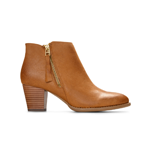
Are Your Shoes Sustainable?

You don’t have to sacrifice style to reduce your carbon footprint.
In an age where sustainability is more important than ever, any efforts made to green-ify your fashion choices are admirable indeed. But, what makes a sustainable shoe?
In this article, we’ll explore the current place of sustainability in the shoe industry, break down three major characteristics of sustainable footwear, and provide expert tips for snagging the perfect pair of eco-friendly kicks.
Sustainability in the Shoe Industry
Is there such a thing as sustainable shoes?
A 2018 study revealed some shocking details about the shoe manufacturing industry in the US—and its carbon footprint:1
- US citizens create higher demand for shoes than any other country—the average US citizen purchases 6.98 pairs of shoes per capita per year.
- The footwear industry emitted 229 kilograms (kg) of CO2 per person to meet US citizens’ demand for shoes in 2018—more CO2 than a commercial jet would emit on a 1,000-mile flight or a passenger car would on a 2,900-mile road trip.
- Manufacturers used over 2,000 gallons of water per person to meet US citizens’ 2018 shoe demand, a volume equivalent to just over 40 baths.
In short, shoe manufacturing requires significant natural resources and creates significant emissions. 2
This is partially due to shoes’ primary materials—many shoe components are made from some form of plastic, a process that both requires extracted fossil fuels and creates significant emissions.
Luckily, shoe manufacturers large and small are making progress in reducing the carbon footprint required to make an average pair of shoes. Recent innovations include:3
- The inclusion of plastic alternatives like bamboo, recycled ocean plastics, and sugarcane
- The development of carbon-neutralizing plans and technologies to offset emissions
- Industry-wide reductions in water use and waste production
Shoppers who wish to build a green closet have more options for sustainable footwear than ever before.

What Makes a Shoe Sustainable?
While sustainable shoes are more accessible than ever, what makes a shoe eco-friendly in the first place? What is sustainable fashion? Before you start your shopping spree, consider the elements below.
#1 Sustainable Materials
Materials will be one of your most vital concerns when shopping for the perfect sustainable shoe. Luckily, however, material information is usually the easiest to come by. So, when you begin shopping, investigate some of the following materials-related factors before heading to the checkout:
- Plastics vs. organic materials – Does the online description or physical box describe the sustainable fashion materials used to construct the shoe? Look for a pair made from naturally-occurring components like bamboo, sugar cane, or organic composites. Shoes made from recycled plastic or recycled materials (like synthetic rubber and even recycled plastic bottles) can also cut the mustard, depending on other factors. Another example of synthetic material is vegan leather.
- Recyclability – A more difficult quest is determining whether or not your ideal shoes are recyclable. While shoes of the past generally can’t be recycled unless you disassemble them, times have changed. Look for shoes with limited materials, which are more likely to meet local recycling center guidelines.
- Eco Friendly Materials sourcing – Are the materials used to make your next pair of shoes ethically and sustainably sourced? For shoes primarily made of plastic, for instance, remember that many fuel products are imported. As such, they tend to rack up a higher carbon footprint than goods made entirely from domestic materials.
#2 Durability
If you’re not the type of shopper to examine every material used to construct your shoe under a microscope, consider a simpler approach to sustainability: prioritizing durability.
Buying a well-made, higher-priced pair of shoes instead of a cheaply-made, low-quality pair both reduces your carbon footprint and saves your wallet.
Let’s explore an example:
- You purchase a pair of new walking sandals for everyday wear for $20.
- After a few months, one shoe breaks, and you immediately replace them with another $20 pair, despite knowing that the cheaper product is less durable.
- If you cycle through one $20 pair of shoes every three months, you’ll spend $160 on shoes during a two-year period.
- If, instead of a poorly-made $20 pair, you invest in a higher-quality pair of walking sandals for $100 that’ll withstand the test of two years’ time, you’ve saved $60—and time spent buying new shoes.
Since shoe manufacturing both requires resources and creates emissions, you also make a more sustainable choice by purchasing the more durable product.
Opting for high-quality goods over cheaply-made fast fashion products is the right decision for the environment—and your checking account—in nearly every case.4
#3 Production Processes
You should also consider if the fashion brand has sustainable practices. Researching a shoe manufacturer’s production processes can provide a window into their commitment (or lack thereof) to sustainable footwear.
While materials and durability are significant factors when searching for eco-friendly shoes, you’ll often find the devil in the details. Try to ascertain the following information before committing to a purchase:
- Importing and exporting – Some shoes are assembled outside the US to avoid environmental manufacturing restrictions. But remember that it takes fossil fuels (and creates emissions) to ship the materials to a facility abroad and send them back to the US.
- Alternative fuel and energy use in production – Does your favorite brand use coal power to keep the lights on in its assembly facility? Research the extent to which your shoe company of choice relies on fossil fuels or coal instead of alternative fuels and renewable energy sources.
- Labor ethics – How does your shoe brand support a sustainable economy? For instance, if your next pair is produced in a facility where workers are underpaid, their workforce likely has no choice but to buy low-quality, inexpensive goods, undermining their ability to make environmentally responsible choices.
How to Find Sustainable Shoes
The information above can take significant effort to find and assess. Fortunately, someone has likely already done the homework for you—you simply need to know where to look.
Consult Customer Reviews
Customer reviews are a gold mine for information about a product you’re considering—if consumers take issue with a company policy, have complaints about durability, or question a brand’s ethics, online reviews offer one of few places to voice their distaste.
Remember that you’re not just looking for negative information. Consult the reviews to discover the advantages of products, too.
There are a few places where you can find comments and information from real people regarding your chosen shoe brand:
- The brand’s product pages and website
- The company’s social media pages
- Third-party forums or message boards
- First-hand accounts from people you know
That said, make sure to prioritize sources that incorporate a variety of different perspectives. An article called “Best Women’s Flat Sandals” may not consider customer reviews, for instance, or only include favorable reviews to generate visibility for certain brands.
Explore Brand Websites
If you’re searching the web for sandals for women, consider exploring your prospective brands’ websites for information about their commitment to sustainable shoes. There are a few types of environmentally-focused pages you might find on a brand’s website:
- Sustainability-specific pages – Some brands may have a whole page—or a separate website—dedicated to their eco-friendly efforts, independent reports, or general sustainability information.
- General activism pages – Many brands prioritize sustainability along with other causes like ethical worker treatment, gender equality, or philanthropic efforts—and information about all of their commitments might coexist on one page.
- Brief or minimalist pages – Some brands embrace minimalism and brevity on their websites. If you have a hard time sussing out how sustainability fits into their business model, look for information elsewhere—their social media pages might be more informative.
Ask the Experts
Don’t you wish someone could tell you which are the best sustainable shoes? There’s an expert in every field. If you’re not sure where to start in your search for sustainable footwear, turn to a qualified professional in your community for advice and information.
Some potential sources could be:
- Your local cobbler – An established shoe repair expert in your area would be very qualified to comment on product durability. Ask them which brands they see most often in need of repairs, and how preventative maintenance can extend the life of your shoes.
- Sustainability experts – Colleges and universities continue to add sustainability-informed courses to their curricula. Consult with an environmentalist expert at your local higher education institution, and ask if they have any insight on sustainable shoe brands.
- Podiatrists or orthopaedists – Doctors specializing in foot health and mobility provide shoe and product recommendations to patients. Even if you’re not currently experiencing any mobility issues, consider asking them for the sustainability run-down on the brands they typically suggest.
It might seem daunting to ask for a professional opinion. However, it’s much easier to ask for advice from someone who’s already done their research than it is to pore over reports, materials lists, and news articles to draw your own conclusion. Plus, a little outside help could get you into a new, eco-friendly pair of shoes more quickly than expected.
Vionic Shoes: Sustainable, Durable, and Fashion-Forward
If you’ve never considered sustainability in your search for the perfect kicks, there’s never a bad time to begin making positive changes for the environment’s sake.
At Vionic, we understand the need for high-quality, comfortable shoes that work for every style—and don’t inflate your carbon footprint. We don’t just care about bringing top-tier shoes to the market—we also care about our community, the environment, and you.
For footwear that serves cloud-nine-level comfort, look no further than our collection of stylish, sustainable, and supportive shoes.
Sources:
- “Measuring Fashion.” Quantis. https://quantis-intl.com/wp-content/uploads/2018/03/measuringfashion_globalimpactstudy_full-report_quantis_cwf_2018a.pdf
- Gorsler, Fabian. “How sustainable is a sneaker really? Two experts weigh in.” Highsnobiety. https://www.highsnobiety.com/p/how-sustainable-is-a-sneaker/
- Bell, Carrie et Dhawan, Nishka. “Best Foot Forward: These 13 Shoe Brands Pair Style With Sustainability.” The Rolling Stone. https://www.rollingstone.com/product-recommendations/lifestyle/best-sustainable-shoes-1159635/
- Oshri, Hadari. “Three Reasons Why Fast Fashion Is Becoming A Problem (And What To Do About It)” Forbes. 13 May, 2019. https://www.forbes.com/sites/theyec/2019/05/13/three-reasons-why-fast-fashion-is-becoming-a-problem-and-what-to-do-about-it/?sh=7f65d31144b2











